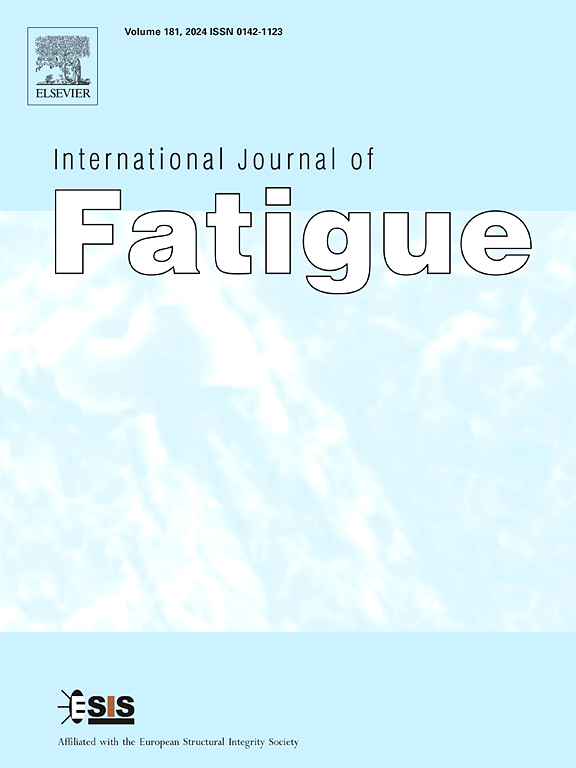Research on the internal and external synergistic strengthening mechanism of fatigue performance of austenitic stainless steel
IF 5.7
2区 材料科学
Q1 ENGINEERING, MECHANICAL
引用次数: 0
Abstract
In this study, the effects of the synergy between pre-tensioning and surface mechanical rolling on the microstructure and fatigue performance of 304 stainless steel were discussed. The 304 stainless steel was subjected to pre-tensioning treatment, and a transformation in the microstructure was observed, with refinement of the grain size accompanied by the occurrence of martensitic transformation, and a quantitative analysis of the martensitic phase change was conducted. The yield strength of 304 stainless steel rises with pre-tensioning, equalizing with tensile strength after 50 % pre-tensioning. The hardness of the specimen was increased after pre-tensioning. After surface mechanical rolling, the hardness values exhibited a gradation decreasing progressively from the surface to the subsurface and then to the center. Based on the rotating bending fatigue test, under the combined effects of 50 % pre-tensioning and surface mechanical rolling, the fatigue limit of the specimen was increased from 365 MPa to 940 MPa, representing an improvement of 157.53 %. Based on the analysis of the properties and microstructure of processed 304 stainless steel, the effects of the pre-tensioning process and surface mechanical rolling on the material are discussed. The mechanism of the process enhancing fatigue properties through the combined effect of pre-tensioning and surface mechanical rolling is discussed.
奥氏体不锈钢疲劳性能内外协同强化机理研究
研究了预张紧与表面机械轧制协同作用对304不锈钢显微组织和疲劳性能的影响。对304不锈钢进行预拉伸处理,观察到显微组织发生转变,晶粒尺寸细化,同时发生马氏体相变,并对马氏体相变进行了定量分析。304不锈钢的屈服强度随预张强度的增加而增加,在预张强度达到50%后与抗拉强度持平。预张紧后试样的硬度有所提高。表面机械轧制后,硬度值从表面到表面下再到中心依次递减。在旋转弯曲疲劳试验的基础上,在50%预张紧力和表面机械轧制的联合作用下,试样的疲劳极限由365 MPa提高到940 MPa,提高了157.53%。在分析304不锈钢加工后的性能和组织的基础上,讨论了预张紧工艺和表面机械轧制对材料的影响。讨论了预张紧和表面机械轧制联合作用提高疲劳性能的机理。
本文章由计算机程序翻译,如有差异,请以英文原文为准。
求助全文
约1分钟内获得全文
求助全文
来源期刊

International Journal of Fatigue
工程技术-材料科学:综合
CiteScore
10.70
自引率
21.70%
发文量
619
审稿时长
58 days
期刊介绍:
Typical subjects discussed in International Journal of Fatigue address:
Novel fatigue testing and characterization methods (new kinds of fatigue tests, critical evaluation of existing methods, in situ measurement of fatigue degradation, non-contact field measurements)
Multiaxial fatigue and complex loading effects of materials and structures, exploring state-of-the-art concepts in degradation under cyclic loading
Fatigue in the very high cycle regime, including failure mode transitions from surface to subsurface, effects of surface treatment, processing, and loading conditions
Modeling (including degradation processes and related driving forces, multiscale/multi-resolution methods, computational hierarchical and concurrent methods for coupled component and material responses, novel methods for notch root analysis, fracture mechanics, damage mechanics, crack growth kinetics, life prediction and durability, and prediction of stochastic fatigue behavior reflecting microstructure and service conditions)
Models for early stages of fatigue crack formation and growth that explicitly consider microstructure and relevant materials science aspects
Understanding the influence or manufacturing and processing route on fatigue degradation, and embedding this understanding in more predictive schemes for mitigation and design against fatigue
Prognosis and damage state awareness (including sensors, monitoring, methodology, interactive control, accelerated methods, data interpretation)
Applications of technologies associated with fatigue and their implications for structural integrity and reliability. This includes issues related to design, operation and maintenance, i.e., life cycle engineering
Smart materials and structures that can sense and mitigate fatigue degradation
Fatigue of devices and structures at small scales, including effects of process route and surfaces/interfaces.
 求助内容:
求助内容: 应助结果提醒方式:
应助结果提醒方式:


